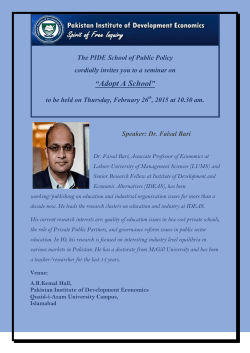
Can Role of Basic Sciences be Minimized
Letters to the Editor Integration in Medical Colleges; Can Role of Basic Sciences be Minimized K. Iqbal1, A. Rahim2 Medical curricula are changing all over the world. Traditional curriculum is being replaced by the integrated system. The content of some basic subjects is also facing drastic changes. Integration is becoming more a philosophy rather than an approach to learning (Wilkerson et al., 2009). Integration in modern medical curricula means to abandon the boundaries between different subjects. In designing the curriculum, partnerships between basic science teachers and clinical faculty were strongly encouraged all over the world. In 1985, Harvard Medical School implemented a hybrid curriculum combining PBL with limited lectures and laboratories, instead of the usual concurrent courses. In Pakistan integrated system has been introduced for over a decade. Some colleges have adopted horizontal and others have preferred vertical integration. But the roles of basic and clinical sciences have yet not been defined in a proper way. The role of the basic sciences as the scientific foundation of clinical medicine gained much prominence and status after Abraham Flexner submitted his seminal report in 1910. The report highly influenced the curriculum design and delivery of medical education, not only in the U.S.A. and Canada, but also across much of the world, including Asia. However, by th the mid-20 century, serious concerns were raised about the lack of clinical relevance while teaching basic science knowledge and concepts delivered to medical students in their early preclinical years. 1 Associate Professor in Anatomy Al Nafees Medical College, Isra University, Pakistan 2 Assistant Professor in Biochemistry Rawal Institute of Health Sciences Bahria University, Pakistan Corresponding author: Dr. KhadijaIqbal Al Nafees Medical College, Isra University Lehtrar Road, Frash Town, Phase - II, Islamabad,Pakistan All over the world medical schools have realized that every department should play a role in teaching the students and no department should forget that, it is no more than a part of the whole which is responsible for the education of a whole student and the fulfillment of the overall objective (Lawson, 2004). In most of the medical colleges in Pakistan the enthusiastic clinical faculty is willing to take over the basic sciences departments. In Asian medical schools concept of integration is new and lot of debate is going on in this part of world (Amin et al., 2004). Some argue that anatomy, as a basic science, lacks connectivity with the living patient, but actually by performing dissection of dead body the students are connected to the dead body as their first patient. Beginning with a lifeless form provides a good understanding of gross anatomy integrated to structure and function which can then be applied to the living. This dispute between share and importance of basic and clinical subjects is becoming a hurdle in integration which is actually the need of the hour. The higher up one goes on the integration ladder, the more important is the communication and joint planning between teachers from different subjects. Agreement between departments may be required concerning the outline of the content and the method of student assessment. The teaching of basic science knowledge, concepts and principles must, therefore, be aimed at inculcating in students, the methods of science and scientific thinking. Thus, courses must now be designed to integrate across the medical disciplines, and departmental barriers must not be allowed to impede the integration process. References Amin, Z., Khoo, H.E., Gwee, M.C.E., Koh, D.R. & Tan, C.H. (2004) Medical Education in Southeast Asia: Emerging Issues, Challenges and Opportunities, Medical Education, 39, pp. 829-832. South East Asian Journal of Medical Education Vol. 8 no.2, 2014 77 Lawson, K.A. & Chew, M. (2004) The new Australian medical schools: daring to be different, Medical Journal of Australia, 181, pp. 662-666. 78 Wilkerson, L., Stevens, C.M. & Krasne, S. (2009) No Content without Context: Integrating Basic, Clinical, and Social Sciences in a Pre- clerkship Curriculum, Medical Teacher, 31, pp. 812-821. South East Asian Journal of Medical Education Vol. 8 no.2, 2014
© Copyright 2025









